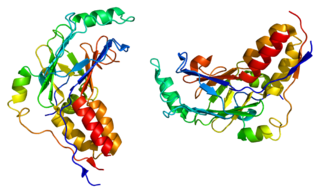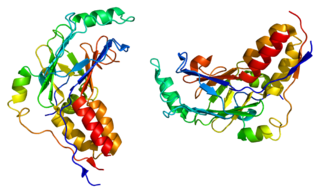E3 SUMO-protein ligase PIAS3 is an enzyme that in humans is encoded by the PIAS3 gene. [5] [6]
E3 SUMO-protein ligase PIAS3 is an enzyme that in humans is encoded by the PIAS3 gene. [5] [6]
The mammalian PIAS family consists of four members: PIAS1, PIAS2, PIAS3 and PIAS4. In Drosophila, a single PIAS homologue named dPIAS/Zimp has been identified. [7] In yeast, two PIAS-related proteins were identified namely SIZ1 and SIZ2. [8] The PIAS family contains more than 60 proteins, most of them transcription factors that can be either positively or negatively regulated through multiple mechanisms.
IAS proteins were originally identified in studies that were aimed to decipher the Janus Kinase (JAK)/STAT signaling pathway. Originally, PIAS3 was found to interact specifically with phosphorylated STAT3 in Interleukin -6 (IL-6) activated murine myeloblast M1 cells. [9] This interaction is mediated via PIAS3 binding to the STAT3 DNA binding domain. Hence, STAT3 transcriptional activity is inhibited by the physical prevention of its binding to target genes. Subsequently, PIAS3 was also found to be a regulator protein of other key transcription factors, including MITF, [10] NFκB, [11] SMAD [12] and estrogen receptor. [13]
PIAS3 protein also functions as a SUMO (small ubiquitin-like modifier)-E3 ligase which catalyzes the covalent attachment of a SUMO protein to specific target substrates. It directly binds to several transcription factors and either blocks or enhances their activity. Alternatively spliced transcript variants of this gene have been identified, but the full-length nature of some of these variants has not been determined. [6]
The SAF-A/B, Acinus and PIAS (SAP) domain is located at the N-terminal of PIAS proteins. [14] This evolutionarily conserved domain is found in proteins ranging from yeast to human and is shared by other chromatin-binding proteins, such as scaffold attachment factor A and B. [15] The SAP domain can recognize and bind to AT-rich DNA sequences present in scaffold-attachment regions/matrix-attachment regions. [16] These elements are frequently found near gene enhancers and interact with nuclear matrix proteins to provide a unique nuclear microenvironment for transcriptional regulation. An LXXLL signature motif is present within the SAP domain of all PIAS proteins. This signature motif has been shown to mediate interactions between nuclear receptors and their co-regulators. [17] It is also essential for the binding of PIAS3 to androgen receptor. The LXXLL motif represents the minimal requirement for the interaction with the NFκB p65 subunit and for the inhibition of NFκB transcriptional activity. [11] It was previously described that the LXXLL motif is also responsible for the retention of PIAS3 in the nucleus.
The Pro-Ile-Asn-Ile-Thr (PINIT) motif represents a highly conserved region of PIAS proteins, which was shown to be involved in the nuclear retention of PIAS3. [18] Within the PINIT domain, the PIAS382-132 region was isolated and characterized as an inhibitory domain that binds and inhibits both the MITF and STAT3 transcription factors. [19] The RING-finger-like zinc-binding domain (RLD) is one of the most conserved domains of the PIAS family and has been shown to be important for PIAS3 activity as a SUMO-E3 ligase. [20] The RLD domain is also involved in the positive regulation of SMAD3 by PIAS3. [21]
PIAS3 has been shown to interact with:

Paracrine signaling is a form of cell signaling, a type of cellular communication in which a cell produces a signal to induce changes in nearby cells, altering the behaviour of those cells. Signaling molecules known as paracrine factors diffuse over a relatively short distance, as opposed to cell signaling by endocrine factors, hormones which travel considerably longer distances via the circulatory system; juxtacrine interactions; and autocrine signaling. Cells that produce paracrine factors secrete them into the immediate extracellular environment. Factors then travel to nearby cells in which the gradient of factor received determines the outcome. However, the exact distance that paracrine factors can travel is not certain.
The JAK-STAT signaling pathway is a chain of interactions between proteins in a cell, and is involved in processes such as immunity, cell division, cell death, and tumour formation. The pathway communicates information from chemical signals outside of a cell to the cell nucleus, resulting in the activation of genes through the process of transcription. There are three key parts of JAK-STAT signalling: Janus kinases (JAKs), signal transducer and activator of transcription proteins (STATs), and receptors. Disrupted JAK-STAT signalling may lead to a variety of diseases, such as skin conditions, cancers, and disorders affecting the immune system.

Transforming growth factor beta (TGF-β) is a multifunctional cytokine belonging to the transforming growth factor superfamily that includes three different mammalian isoforms and many other signaling proteins. TGFB proteins are produced by all white blood cell lineages.

Histone acetyltransferase p300 also known as p300 HAT or E1A-associated protein p300 also known as EP300 or p300 is an enzyme that, in humans, is encoded by the EP300 gene. It functions as histone acetyltransferase that regulates transcription of genes via chromatin remodeling by allowing histone proteins to wrap DNA less tightly. This enzyme plays an essential role in regulating cell growth and division, prompting cells to mature and assume specialized functions (differentiate), and preventing the growth of cancerous tumors. The p300 protein appears to be critical for normal development before and after birth.

Mothers against decapentaplegic homolog 2 also known as SMAD family member 2 or SMAD2 is a protein that in humans is encoded by the SMAD2 gene. MAD homolog 2 belongs to the SMAD, a family of proteins similar to the gene products of the Drosophila gene 'mothers against decapentaplegic' (Mad) and the C. elegans gene Sma. SMAD proteins are signal transducers and transcriptional modulators that mediate multiple signaling pathways.

Mothers against decapentaplegic homolog 3 also known as SMAD family member 3 or SMAD3 is a protein that in humans is encoded by the SMAD3 gene.

SMAD4, also called SMAD family member 4, Mothers against decapentaplegic homolog 4, or DPC4 is a highly conserved protein present in all metazoans. It belongs to the SMAD family of transcription factor proteins, which act as mediators of TGF-β signal transduction. The TGFβ family of cytokines regulates critical processes during the lifecycle of metazoans, with important roles during embryo development, tissue homeostasis, regeneration, and immune regulation.

SMAD family member 6, also known as SMAD6, is a protein that in humans is encoded by the SMAD6 gene.

Mothers against decapentaplegic homolog 7 or SMAD7 is a protein that in humans is encoded by the SMAD7 gene.
Smads comprise a family of structurally similar proteins that are the main signal transducers for receptors of the transforming growth factor beta (TGF-B) superfamily, which are critically important for regulating cell development and growth. The abbreviation refers to the homologies to the Caenorhabditis elegans SMA and MAD family of genes in Drosophila.
The transforming growth factor beta (TGFB) signaling pathway is involved in many cellular processes in both the adult organism and the developing embryo including cell growth, cell differentiation, cell migration, apoptosis, cellular homeostasis and other cellular functions. The TGFB signaling pathways are conserved. In spite of the wide range of cellular processes that the TGFβ signaling pathway regulates, the process is relatively simple. TGFβ superfamily ligands bind to a type II receptor, which recruits and phosphorylates a type I receptor. The type I receptor then phosphorylates receptor-regulated SMADs (R-SMADs) which can now bind the coSMAD SMAD4. R-SMAD/coSMAD complexes accumulate in the nucleus where they act as transcription factors and participate in the regulation of target gene expression.

Activin receptor type-1B is a protein that in humans is encoded by the ACVR1B gene.

Protein inhibitor of activated STAT (PIAS), also known as E3 SUMO-protein ligase PIAS, is a protein that regulates transcription in mammals. PIAS proteins act as transcriptional co-regulators with at least 60 different proteins in order to either activate or repress transcription. The transcription factors STAT, NF-κB, p73, and p53 are among the many proteins that PIAS interacts with.

Signal transducer and activator of transcription 5 (STAT5) refers to two highly related proteins, STAT5A and STAT5B, which are part of the seven-membered STAT family of proteins. Though STAT5A and STAT5B are encoded by separate genes, the proteins are 90% identical at the amino acid level. STAT5 proteins are involved in cytosolic signalling and in mediating the expression of specific genes. Aberrant STAT5 activity has been shown to be closely connected to a wide range of human cancers, and silencing this aberrant activity is an area of active research in medicinal chemistry.

Signal transducer and activator of transcription 3 (STAT3) is a transcription factor which in humans is encoded by the STAT3 gene. It is a member of the STAT protein family.

Lymphoid enhancer-binding factor 1 (LEF1) is a protein that in humans is encoded by the LEF1 gene. It's a member of T cell factor/lymphoid enhancer factor (TCF/LEF) family.

E3 SUMO-protein ligase PIAS4 is one of several protein inhibitor of activated STAT (PIAS) proteins. It is also known as protein inhibitor of activated STAT protein gamma, and is an enzyme that in humans is encoded by the PIAS4 gene.

E3 SUMO-protein ligase PIAS1 is an enzyme that in humans is encoded by the PIAS1 gene.

E3 SUMO-protein ligase PIAS2 is an enzyme that in humans is encoded by the PIAS2 gene.
The Nodal signaling pathway is a signal transduction pathway important in regional and cellular differentiation during embryonic development.